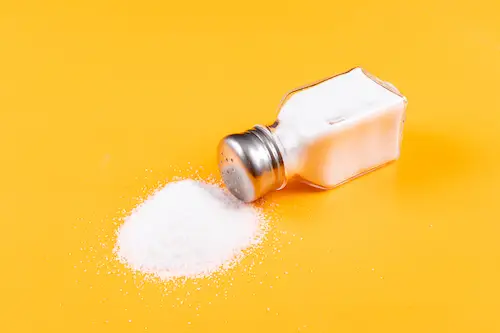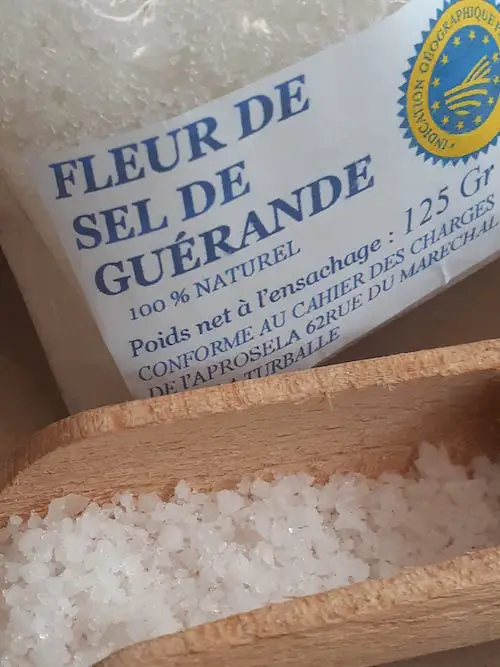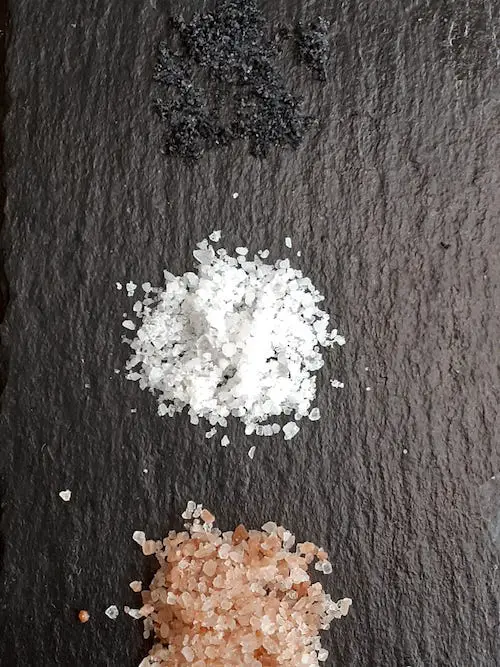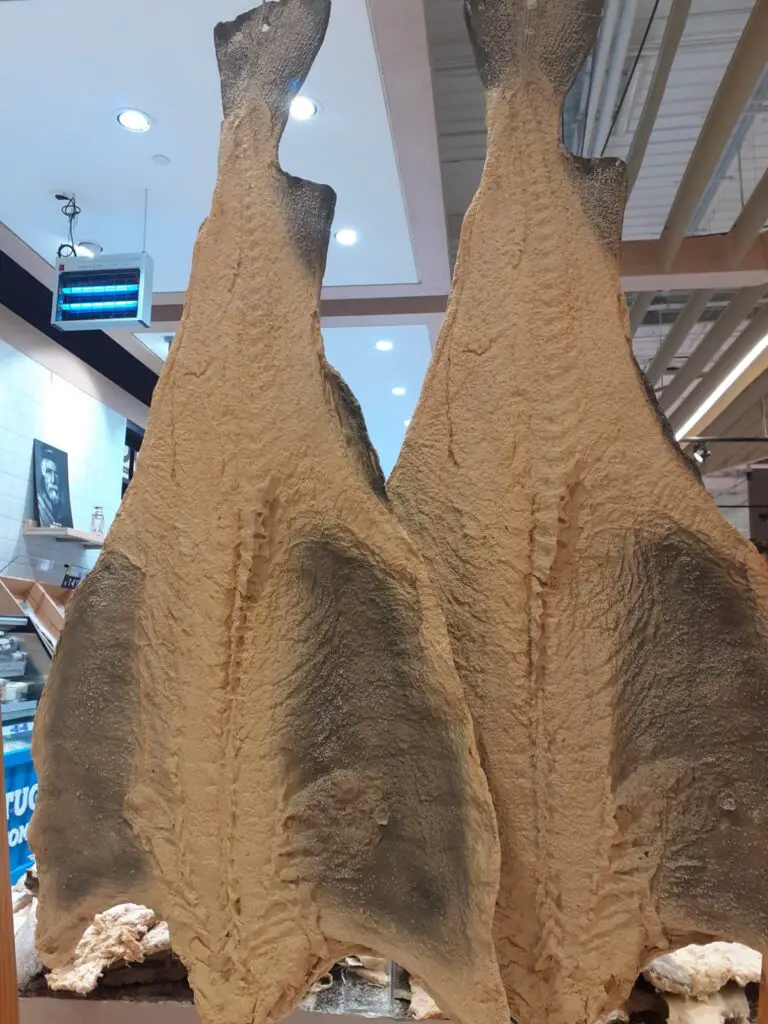This post contains affiliate links. When you buy through our links, we may earn a commission.

- What is salt made of?
- Where does salt come from to season our dishes?
- How do we obtain the table salt that we find on our plates?
- Harvesting salt and its different forms
- The varieties of salt
- Is salt useful in our diet?
- How much salt should we consume?
- Does salt have an impact on our health?
- How can you be over-salted?
- Four actions that will have an immediate impact on your salt intake
- The seven tips to add flavor to your dishes without forcing salt
- Salt is also used for other purposes
We put it everywhere in our dishes, and even when we don’t use it, it is always present in our food without us even knowing it sometimes: it is salt.
You can experiment with preparing a dish without salt or with salt. Cooking without salt is bland.
There is no doubt that salt is a natural flavor enhancer and indispensable ingredients in cooking.
In all recipes, salt is always included in the list of ingredients.
In any case, we consume far too much of it! 9 to 12 grams on average per day, according to figures from the WHO the World Health Organisation.
This may not seem like a lot at first glance, but our bodies need only half as much.
So how can we reduce our salt intake? Is there a way to go without salt? Which salt should we choose?
We put our spin on this much-loved condiment and tell you all about it. Here we go!
In this article, we share the seven tips to add flavor to your dishes without using too much salt.
What is salt made of?
Salt is a condiment also called sodium chloride that contains, on average, 77% sodium chloride, 16% magnesium, 4% calcium, and 2% potassium.
Where does salt come from to season our dishes?
Salt is naturally contained in seawater. Salt is mined from the sea, but there are also salts from underground mines.
We have the last French salt mine in Varangéville in Lorraine. Salt from underground mines is called rock salt.
Rock salt is a mineral deposit containing a high concentration of edible salt. These salt deposits were formed by the ancient evaporation of lakes or inland seas.
Salt is mined in salt marshes on the Mediterranean and Atlantic coasts in France.

Camargue salt and Guérande salt, the two best-known salts, are produced there. The latter is obtained by artisanal processes, worked by hand, as in the past.
Otherwise, the vast majority of salt is produced industrialized using machines and in huge quantities.
How do we obtain the table salt that we find on our plates?
The salt is concentrated to crystallize with the heat of the water and the wind.
This is a physical phenomenon called evaporation. The water evaporates, and the minerals crystallize.
You can easily experiment yourself. If you heat seawater in a pan, the water will gradually evaporate to leave a white crystallized deposit, the salt.
Harvesting salt and its different forms
Salt comes in 4 different forms:
- Grey salt
- Coarse salt
- Refined salt
- Fleur de sel
Grey salt: Grey salt is said to be unrefined. It is natural. It is the trace elements that give this gray color. It is the deposit of salt mixed with the clay in the soil in contact with the salt.
The flower of salt: The flower of salt is naturally white. It is the fine layer of salt collected on the surface of the crystallization of salt. We like it for its texture and its crunchy side.
Refined fine salt: Refined fine salt is white and is the one we mostly find at the table. Refining is an industrial process that whitens the salt, crushes it, and transforms it into a powder, to which additives, such as anti-caking agents and fluorinated or iodized compounds are usually added.
Coarse refined salt: Coarse refined salt has also undergone the process of refining. It is used for salt in cooking, for brines, or in salt mills.
Natural salt is not refined and still contains all its natural minerals, sodium chloride in the majority, and magnesium, calcium, and potassium. Natural salts, therefore, have different taste properties and appearances depending on the amount of minerals they contain. Thus, flower of salt or sea salt harvested by hand has a unique flavor that changes from one region to another.
The varieties of salt
Salt is found in France and the four corners of the world, and there are different varieties.
Salt is not always white. There are other varieties of salt, and some are even colored.

In France, Camargue salt is naturally pink. No additives are added. The color is due to an alga that grows in the salt flats and gives its pink color.
Then the grey salt, suitable for consumption, is salt without treatment with cemented clay which gives the greyish side. It is mainly made of sodium chloride, but it also contains magnesium, calcium, and potassium.
In Pakistani mines, we find Himalayan salt, a naturally pink rock salt that is now easily marketed in Europe at affordable prices. Delicate and soft, it owes its color to its iron content.
There is also a black salt, for example, Cyprus salt, which is loaded with sulfur, ideal for recalling the smell of the egg in vegan cooking.
Also, red salt is harvested in Hawaii. The volcanic clay that falls down the slopes during the rainy season ends up in the sea, which colors the salt red and gives it a nutty taste.
Persian blue salt is a rock salt extracted from the mines of the Semnan province in Iran. It owes its bluish hues to the presence of sylvinite, a compound close to potassium. As for him, he arouses curiosity for lack of an indisputable adhesion. It is said to have an aftertaste of spices and lemon.
Is salt useful in our diet?
We need salt for our bodies. It is vital because we do not know how to make it.
It is a mineral essential to our existence. We cannot live without salt. We need it to regulate the water in the body. Otherwise, we get dehydrated.
How much salt should we consume?
Salt is essential to the proper functioning of the body, but in excess, it turns out to be a real poison for our health.
According to the World Health Organization, we consume 9 to 12 grams of salt per day. A figure far exceeds the intake our body needs since the recommendation is to consume 5 grams per day per person.
To understand how much salt we need to consume, 5 grams is equivalent to the size of a teaspoon.
Does salt have an impact on our health?

It is now known that the overconsumption of salt is linked to hypertension or cardiovascular diseases. The amount of salt consumed has a real impact on our health.
But it’s not that simple when you’re talking about a few grams! The proportions can remain derisory for some.
But when we accumulate salt on our plates during the day, we realize that the quantities are quickly exceeded.
As a result, it is not so easy to become aware of our overconsumption and reduce our quantities of salt! Especially when salt is hidden in foods where we don’t expect it.
“Most people don’t know how much sodium they are consuming or its risks,” said Dr. Tedros Adhanom Ghebreyesus, Director-General of the WHO.
How can you be over-salted?
We are not only talking about the pinch of salt added to cooking or at the table but also about the salt hidden in the ready-to-heat products on sale in the stores.
80% of our salt intake is not only found in our salt shaker but also prepared meals and processed products.
Then the worst is the hidden salt that we don’t necessarily see and have trouble quantifying.
In addition to the hidden salt and the salt that we use to season our dishes.
Some concrete examples of realizing the importance of reducing salt in our diet:
- A slice of sausage
- One handful of potato chips
- Four slices of bread
- One slice of pizza
- One bowl of soup
Four actions that will have an immediate impact on your salt intake
► Limit salt
- Limit the purchase of highly salted processed foods.
► Measure salt well, and don’t overuse it.
The little trick: Flavor your salt just like the Japanese condiment: gomasio, a mixture of toasted and ground sesame and sea salt.
► Simply replace it, and below we’ll look at the seven best ways to add flavor to your dishes without forcing salt.
► Change your habits
- We remove the salt shaker at mealtime at the table. It saves us from being asked.
- We choose to taste before salting without knowing if the dish is already salty enough or not.
- Adding salt at the beginning of cooking gives it time to migrate into the food pieces, seasoning them throughout. Meanwhile, if you only add salt at the end, it provides a more concentrated surface coating that hits your tongue immediately.
The seven tips to add flavor to your dishes without forcing salt
- Use sodium-free salt. There is such a thing as 99% of sodium is replaced by potassium. This allows you to keep the taste of salt without any complications.
Be careful; it is not recommended for people with kidney failure, and you should talk to your doctor before doing anything.
However, potassium salt has a robust and bitter taste. It is best to add salt during cooking or in simmered dishes. It helps to limit the negative effect of sodium. - A good alternative is to use potassium condiment bases with added vegetables, seaweed and herbs. The vegetables increase the flavor. This is a perfect alternative.
- Pickling can also be an excellent way to season food without adding salt.
- Cooking in foil and simmering dishes also develops slow-cooked foods’ flavors and allows you to cook without salt.
- Make your own homemade vegetable/spice broth.
- Using foods that are already naturally salty for seasoning is a real solution.
- Use foods or beverages that bring a strong taste, a complex and fresh aromatic note.
Choose red wines, white wines, beer, or cider.
Beyond being appreciated by the glass, wine can easily be used in cooking and bring undeniable gustatory qualities.
Salt is also used for other purposes
We cook meat or fish in a salt crust. The salt crust (paste + salt) allows cooking the food in the stew.
Salt allows the preservation of food because it absorbs water. It was the primary way to preserve meat and fish in the past.
Currently, this process is still used. It can be found in the salting of codfish or ham, such as Bayonne ham.

Salt also preserves butter and cheese.
Salt is a condiment that we can’t do without. Still, with a bit of culinary imagination and inspiration from other foods or beverages such as spices, oils, and alcohols, we can achieve wonders in the kitchen with taste without forcing the salt.
I hope this article has provided you with some valuable information, and feel free to share a comment!
Enjoy your meal!
Are there any additives in Camargue salt?
No. The pink-colored Camargue salt of the controlled appellation does not contain any additive. Thanks to an alga, it is 100 % natural and gets its color naturally.
Which salt is better for your health?
When it comes to comparison, salts have different concentrations of sodium chloride and other minerals, giving them different taste qualities. As far as health benefits are concerned, salt is essential to the body in small doses since it provides the sodium chloride we need to keep our bodies functioning correctly.
I can't eat salt. What can I replace it with?
We share seven ways to replace salt in your diet in our article. If you can't eat salt for health reasons, you can replace it by adopting new habits.
What processed foods contain salt?
The food groups that contribute the most sodium to the diet are bread and rusks, deli meats, mixed dishes (all categories), cheeses, snacks, fast foods, and condiments and sauces.
How can I prevent salt from compacting in my salt shaker?
It is usual to put a few raw rice grains in the salt shaker to absorb moisture when the anti-caking agents are not effective enough.
